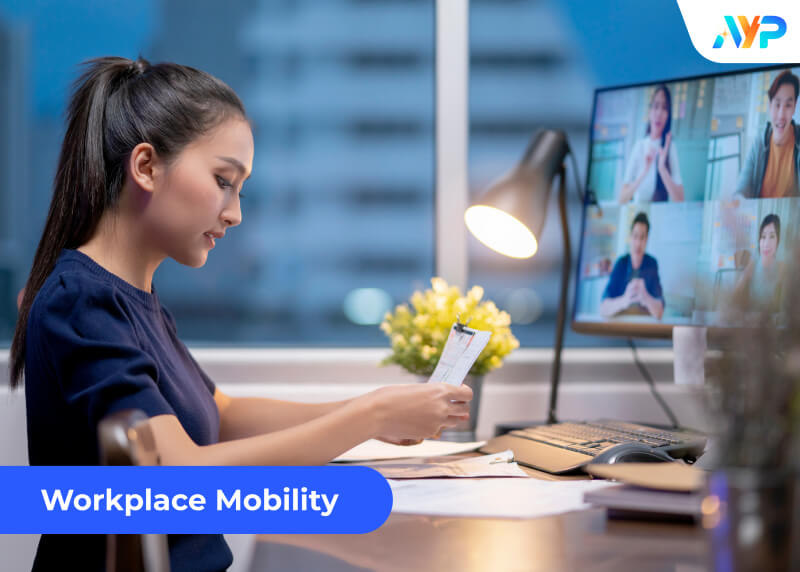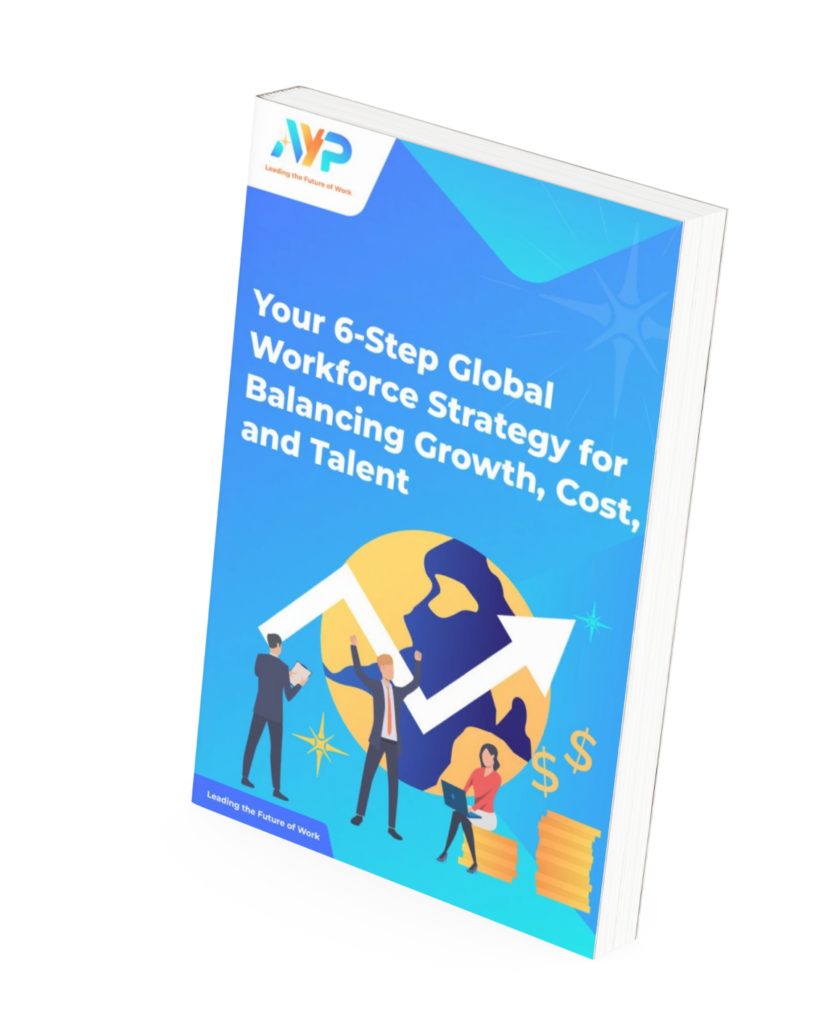What is workplace mobility? Is it the same as global mobility? Not exactly, but it is often used interchangeably.
Workplace mobility refers to the flexibility and mobility within a specific workplace or office environment. It focuses on the ability of employees to move within a physical workspace and utilize different workspaces to perform their tasks effectively. Often organizations establish distributed workforce to expand into new markets.
Global mobility refers to the ability of individuals or employees to move and work across different countries or regions. Often, global mobility requires individuals to relocate for employment purposes within the same organization or another company.
According to Gartner, 25% of people will spend at least 1 hour per day in the metaverse for work, social, education, and entertainment. In this article, we will discuss the factors leading to workplace mobility, the transforming trends, how to get wider access to the talent pool when workplace mobility becomes prevalent, and the competitive advantage you can bring in as an HR leader leading the future of work.
The accelerating technology
One of the top preferences for companies searching for business expansion is Asia Pacific. SEA's online economy is estimated to surpass 1 trillion by 2030. The supply chain industry is also investing in this region to serve global consumers.
In fact, as of April 2023, 356 cities are already accessible to 5G services. The Philippines is a country that has the widest 5G coverage among all SEA countries. In Asia, China has the highest number of cities to have access to it 1.
In Malaysia, the 5G coverage has reached 62% for populated cities as of May 2023, shared by the Minister of Communication and Digital. The country is on track to achieve 80% of 5G network coverage by the end of 2023 2.
Despite the Asia Pacific rollout of 5G networks much slower than other developed countries, Asia Pacific is on track to become the most prominent 5G market globally.
Regarding current 5G performance, Seoul, Korea, and Kuala Lumpur, Malaysia, are the top 2 APAC cities performing well with a median download speed of 534 Mbps and 523 Mbps, respectively 3.
Besides that, Delhi and Mumbai (India) reported over 300 Mbps median download speed in H1 2023 even though both cities had just started the 5G network.
How is the accelerating 5G trend associated with workplace mobility? With the quick adoption and prevalence of 5G, real-time interactions and collaborations will be seamlessly integrated into our daily working life.
Hiring remote employees from these cities will likely experience enhanced internet connectivity for better job execution. Augmented reality-based meetings and cloud-based applications from both mobile and laptops will further empower the ease of remote work, allowing people to connect and work distributedly.
Space demand changes in theworkplace
The hybrid work model and back-to-the-office policies are not foreign terms after the global disruption. Key technology leaders are advocating "in-person collaboration" to improve creativity and innovation even though employees are protesting that where they work doesn't directly contribute to higher levels of workforce productivity.
The new hybrid hub concept with a networking model as the foundation supports the future of work. How hybrid will the future workforce look? 39% of global office employees are anticipated to work in hybrid mode by the end of 2023, of which 71% are happening in the US 4.
On the other hand, 37% of Asia-Pacific companies have expanded their office portfolio over the past 3 years, while only 25% went downsizing 5.
Businesses are experiencing organic business growth, hence competitive for investors to consider expanding in the APAC region.
In regards to the industry, business services, and financial services generally reported higher office utilization rates, but only 60% of space utilization rates were reported from tech companies in Asia.
Most of the companies in APAC believed that direct performance and better workforce productivity could result from returning back to the office. Hence, it is more toward the perception favoring back-to-office collaboration instead of a lack of technology readiness in APAC.
Nevertheless, workplace mobility has indeed reshaped how companies are usually operating. 48% of APAC companies have implemented flexible seating in 2023 and is expected to grow to 80% in 2025 6.
The future of work
Decentralization of workspaces is taking place where the workplace serves as a networking hub to foster collaboration and in-person interactions rather than aiming to improve employee productivity when time well spent is the new measure of success to gauge employee productivity level.
EY, a leading example of the distributed workforce in over 150 countries with 700 office locations, defined the future of work as a place to meet, collaborate, and build strong teams, not just a place to work 7.
Therefore, EY plans to acquire and utilize flexible office space that supports different activities for employees to perform and improve the networking experience.
When it comes to human interaction, an interesting survey with 750 technology professionals found that 3 out of 5 tech talent would be interested in using virtual reality headsets for training and learning, and 52% have at least some plans to move towards metaverse for work production 8.
Will metaverse bring another transformation to the hybrid work model to fully remote? Only time will tell when the metaverse becomes prevalent.

With those foundations established, companies may start to rethink their future workspace and aim to deliver a positive employee experience, enhancing it with human-centric building interactions supported by real-time data technology innovations such as AI, extended reality, and digital twins.
Unlock the global markets: Access to wider talent pools
Workplace mobility is closely related to borderless hiring when flexibility and mobility within a specific location are emphasized, mainly when high-growth companies penetrate new foreign markets.
Despite fully remote or work from home opportunities declines compared to the pandemic's peak, borderless hiring is still higher compared to 2019. 27% of CEOs in the tech sector are still actively looking for opportunities to hire borderless tech employees, and 58% have at least some plans to implement it.
For companies aiming to scale fast and flexibly, hiring candidates from emerging countries will help your company save massive hiring costs.
You might need a senior software developer to improve the product's technology infrastructure or to grow the user base's demand by developing scalable software solutions; hiring a candidate with 9 to 15 years of experience from Southeast Asia could help you to save up to $76,500 per annum.
Download our salary guide to see how much cost savings you can achieve and why you should hire from emerging countries for a long-term growth perspective to expand your business globally.
The right workplace model: Employee engagement & experience
According to Deloitte's latest 2023 Global Human Capital Trends survey with 10,000 HR and business leaders in over 105 countries 9, 87% of business leaders think that the right workplace model is vital to lead the organization's success.
Yet, only 24% are ready to address this trend, and 78% are attempting to build a future workplace where employees can thrive by redesigning their current work processes.
The emphasis is more on the workplace's design, practice, and functionality rather than the physical location itself. Deloitte advised that traditional boundaries will need to be challenged.
The future of work advocates that employees can determine where, when, and how to produce their work guided by broad guidelines aimed to empower them but not restrict them.

Whether in a physical, hybrid, or digital environment, respecting employee preferences by looking into factors such as culture, teamwork, and community is far more critical to increase employee productivity; reducing the amount of time commuting to increase employee satisfaction leads to positive customer experience and positive business outcomes.
While expanding overseas, you might be concerned about conducting fair business performance reviews and employee performance management when setting up your distributed workforce.
As a leading example for the future of work, AYP has assisted numerous clients in expanding to over 17 countries. Here is our guide to share our best practices to measure employees' productivity when hiring from anywhere.
HR leading role for the future of work
Increasing workplace mobility enhances employee satisfaction. Employees satisfied with the company's flexible work policy are twice as likely to recommend their company to their contacts 10.
LinkedIn talent trend report revealed that the top 3 priorities when considering a job are compensation, work-life balance, and flexibility. Therefore, borderless hiring from emerging countries can fulfill the top 3 priorities that talents seek; it helps improve the employee experience and reduces employee disengagement rates.

How can HR add value in the future world of work?
- Digitization will elevate the HR industry. HR should focus on automatizing routine processes to make better-informed decisions on employee data to understand the employee's journey 11
- Focusing on advising top management in workplace redesign purpose suggestions and global talent acquisition strategy when routine administrative tasks are automated and delivered through self-service platforms.
- Engaging an EOR solution provider could help your organization become more agile and fluid if your business aim is to expand quickly to foreign countries without setting up a legal entity.
Workplace mobility: Cross-border hiring
Are you considering implementing a cross-border remote work policy in your organization?
A lack of understanding of the tax, social security, Labor laws, and legal reporting obligations could lead your company at risk.
Or are you looking for a long-term solution to digitize and optimize your HR processes?
References
- Number of cities in which 5G is available 2023 by country
- Fahmi: Malaysia’s 5G coverage now at 62.1%
- 5G in Asia Pacific: Deployment Momentum Continues
- All data, everywhere, all at once: Can 5G create the perfect future workspace?
- 2023 Asia Pacific Office Occupier Sentiment Survey
- Asia Pacific Leads The Return To Office With 65% Utilization Rates
- Are you prepared for Future of Work?
- Some Companies Are Starting to Embrace the Metaverse. Many Tech Employees Are Interested in Doing Certain Work Tasks in Virtual Reality
- Activating the future of workplace
- Hiring continues to slow around the world
- What is the future of work?



